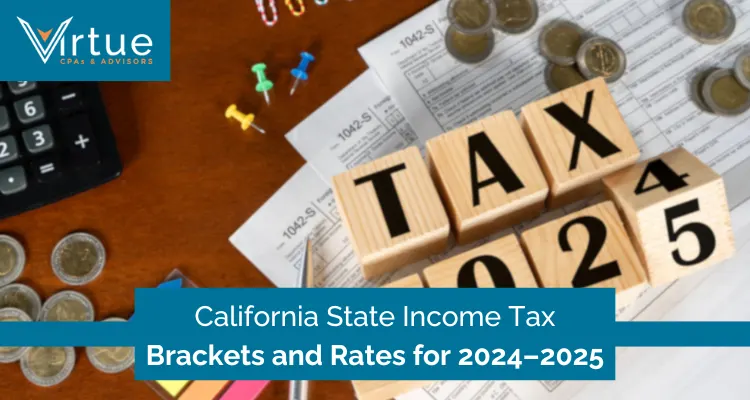California's tax landscape continues evolving, and understanding the 2024-2025 income tax brackets is crucial for smart financial planning. Whether you're a law firm partner managing compensation structures, a CFO planning year-end strategy, or an office manager handling payroll compliance, California's nine progressive tax brackets directly impact your bottom line.
The Golden State maintains some of the nation's highest tax rates, with brackets ranging from 1% to 13.3% when including surcharges. Recent legislative changes, particularly the elimination of payroll tax wage ceilings, create new planning opportunities and challenges for high-earning professionals and business owners.
This comprehensive guide breaks down everything you need to know about California's 2024-2025 tax brackets and provides actionable insights for strategic tax planning.
What Are California's 2024-2025 Income Tax Brackets?
California operates nine progressive income tax brackets for 2024, ranging from 1% to 12.3% for regular income. The state also imposes an additional 1% Mental Health Services Tax on taxable income exceeding $1 million, creating an effective top rate of 13.3%.
These brackets apply to income earned during 2024 and reported on tax returns filed in 2025. The structure ensures that only income within each bracket is taxed at that specific rate, not your entire income.
Key Tax Statistics for 2024-2025:
- Nine progressive brackets: 1%, 2%, 4%, 6%, 8%, 9.3%, 10.3%, 11.3%, 12.3%
- Additional 1% surcharge on income over $1 million
- Standard deductions: $5,540 (single/married filing separately), $11,080 (married filing jointly/head of household)
- New payroll tax expansion eliminates SDI wage ceiling
How California Taxes Change by Filing Status?
California's tax brackets Change significantly based on your filing status. Law firm partners and professional service owners should understand these differences when structuring compensation and planning distributions.
Complete California Tax Brackets for 2024 (Income Earned in 2024, Filed in 2025)
| Single or Married/RDP Filing Separately | Married/RDP Filing Jointly or Qualified Surviving Spouse | Head of Household | Rate |
|---|---|---|---|
| $0 – $10,756 | $0 – $21,512 | $0 – $21,527 | 1.00% |
| $10,756 – $25,499 | $21,512 – $50,998 | $21,527 – $51,000 | 2.00% |
| $25,499 – $40,245 | $50,998 – $80,490 | $51,000 – $65,744 | 4.00% |
| $40,245 – $55,866 | $80,490 – $111,732 | $65,744 – $81,364 | 6.00% |
| $55,866 – $70,606 | $111,732 – $141,212 | $81,364 – $96,107 | 8.00% |
| $70,606 – $360,659 | $141,212 – $721,318 | $96,107 – $490,493 | 9.30% |
| $360,659 – $432,787 | $721,318 – $865,574 | $490,493 – $588,593 | 10.30% |
| $432,787 – $721,314 | $865,574 – $1,442,628 | $588,593 – $980,987 | 11.30% |
| $721,314 and over | $1,442,628 and over | $980,987 and over | 12.30% |
What Major Tax Changes Affect 2024-2025 Planning?
The most significant change for 2024 involves the elimination of the State Disability Insurance (SDI) wage ceiling, previously capped at $153,164. This change subjects all wage income to the 1.1% SDI tax, creating an effective 14.4% top rate for wages exceeding $1 million.
For law firm partners and high-earning professionals, this represents a substantial shift in tax burden calculations. The change particularly affects compensation planning for those considering stock options, bonuses, or salary versus distribution strategies.
Who's Most Impacted by These Changes?
- High-Income W-2 Employees: Now face unlimited SDI tax on wages above the previous ceiling, significantly increasing their effective tax rate.
- Law Firm Partners: Must reevaluate salary versus distribution strategies to optimize tax efficiency under the new rules.
- Professional Service Executives: Those with substantial bonus or commission income experience notably increased marginal tax rates.
- Business Owners: Face complex planning challenges around compensation structure optimization and entity election considerations.
Should You File Jointly or Separately in California?
California's progressive structure often favors joint filing for married couples, but specific circumstances may benefit from separate returns. Law firm partners with significant income disparities should analyze both approaches annually.
When Joint Filing Benefits Your Tax Strategy:
- Similar Income Levels: Couples with comparable earnings maximize bracket utilization effectively, with doubled thresholds avoiding unnecessary progression into higher rates.
- Substantial Deductions: When one spouse has significant business deductions that benefit the entire household's income reduction strategy.
- Lower Combined Brackets: Joint income that stays within favorable brackets prevents premature escalation into higher marginal rates.
When Separate Filing May Help:
- Significant Income Disparity: Allows the lower-earning spouse to utilize lower tax brackets more effectively than combining incomes.
- Business Loss Limitations: When one spouse has substantial business losses, that might be limited under joint filing rules.
- Multi-State Complications: Different state residency situations that create complex allocation issues requiring careful separation.
Which California-Specific Deductions and Credits You Should Know?
California offers unique tax benefits that differ significantly from federal provisions. Understanding these opportunities helps law firms and professional service businesses optimize their tax strategies effectively.
1. Standard Deduction for 2024
California's standard deduction provides immediate tax savings for eligible taxpayers. For the 2024 tax year (filed in 2025):
- Single or Married Filing Separately: $5,540
- Married Filing Jointly, Head of Household, Qualifying Surviving Spouse: $11,080
2. Personal Exemption Credit System
Unlike most states that offer deductions, California converts personal exemptions into credits, providing dollar-for-dollar tax reduction. This approach benefits all taxpayers regardless of income level, though high earners see proportionally less benefit compared to lower-income taxpayers.
The credit amounts adjust annually for inflation, making yearly verification essential for accurate planning. Law firm partners with multiple dependents often see substantial savings through California's credit structure.
3. California Earned Income Tax Credit (CalEITC)
The CalEITC provides significant relief for low-to-moderate income taxpayers, offering up to $3,644 for tax year 2024. Unlike federal EITC, California's version extends to higher income levels and includes workers without children in specific circumstances.
Eligibility extends to households earning up to $31,950 annually, creating planning opportunities for business owners with a variable income. Strategic timing of income recognition can maximize credit eligibility for qualifying taxpayers.
4. Young Child Tax Credit (YCTC)
Families with children under six may qualify for additional credits up to $1,154 per return for tax year 2024. This credit works in conjunction with CalEITC, providing substantial relief for qualifying families even without earned income in certain years.
5. Business-Specific Credits Law Firms Should Consider
- Research and Development Credit: Provides substantial benefits for law firms investing in legal technology and innovation initiatives.
- New Employment Credit: Rewards firms creating jobs in designated enterprise zones, particularly relevant for expanding practices.
- Energy Efficiency Credits: Support firms investing in renewable energy systems and sustainable office improvements.
- Child and Dependent Care Credit: Depending on your income, this credit can cover up to 50% of care expenses, up to a maximum of $3,000 expenses for one child and $6,000 expenses for two dependents.
How Should Law Firms Optimize Business Tax Planning?
California's tax structure significantly influences optimal entity selection and compensation strategies for professional service businesses. Law firms should regularly evaluate their structure to ensure maximum tax efficiency.
1. Entity Selection Impact on California Taxes
S-Corporation elections often provide optimal tax efficiency for profitable law firms operating in California. The election allows partners to reduce self-employment taxes while maintaining flow-through taxation benefits, particularly valuable given California's high individual rates.
LLC members should carefully evaluate tax elections, especially for multi-member firms. The default partnership taxation may not optimize California tax efficiency, making elections for S-Corporation status worthy of analysis.
Professional corporations face unique considerations under California law, requiring specialized planning to optimize both federal and state tax outcomes while maintaining compliance with professional regulations.
2. Compensation Structure Optimization for Partners
The 2024 payroll tax changes necessitate comprehensive compensation structure reviews for law firm partners and executives. Traditional salary optimization strategies require updating to account for unlimited SDI taxation on wages.
- Reasonable Salary Requirements: Ensure compliance while minimizing payroll tax exposure effectively through strategic salary-to-distribution ratios.
- Distribution Timing Strategies: Shift income between tax years to optimize bracket utilization and manage overall tax liability strategically.
- Deferred Compensation Plans: Provide long-term tax deferral opportunities for high-earning partners while building retirement wealth effectively.
- Bonus and Incentive Planning: Requires careful timing to minimize California tax impact while maintaining competitive compensation packages.
What Strategies Work for High-Income Earners?
Reaching $1 million in taxable income triggers California's additional 1% mental health services tax, creating effective rates exceeding 13%. This threshold demands sophisticated planning strategies to minimize impact while maintaining full compliance.
1. The Million-Dollar Income Threshold Challenge
Income timing strategies become critical near this threshold. Law firm partners can defer income recognition, accelerate deductions, or restructure transactions to manage taxable income levels strategically without compromising business operations.
Professional service businesses often benefit from year-end planning that considers multi-year income patterns rather than focusing solely on current-year optimization.
2. Residency Planning Considerations
California's high tax rates drive many high earners to consider residency changes. However, California maintains strict rules for establishing non-residency, requiring comprehensive planning and documentation to achieve legitimate tax savings.
- Critical Residency Factors: Days present in California require careful tracking and documentation annually to support non-resident claims.
- Business Connection Management: California connections create ongoing residency presumptions that require strategic planning to address properly.
- Documentation Requirements: Family ties, property ownership, and voter registration create presumptions requiring careful management and professional guidance.
What Common Mistakes Should You Avoid?
California's complex tax environment creates numerous compliance pitfalls that can be expensive to resolve. Law firms and professional service businesses should understand these common issues to prevent costly mistakes.
1. Estimated Tax Payment Errors
California's high tax rates make estimated tax compliance critical for avoiding penalties. Many taxpayers underestimate their liability or fail to account for California-specific requirements that differ from federal rules significantly.
The safe harbor rules for California differ from federal requirements, particularly for high-income taxpayers. Understanding these differences prevents costly penalties and cash flow surprises during tax season.
2. Recordkeeping and Documentation Challenges
California's complex tax environment demands meticulous recordkeeping, especially for multi-state law firms and high-income partners. Poor documentation often results in lost deductions, credit disallowances, and audit complications.
Essential records include detailed business expense documentation, income source verification, and residency supporting materials. Digital recordkeeping systems often provide superior organization and accessibility compared to traditional paper systems.
3. Filing Requirements and Deadlines
California income tax returns follow the federal tax deadline which falls on April 15, 2025. If you can't file on time, you can request an automatic six-month extension. However, payments are still due by April 15, 2025, even with an extension.
Those in areas of California that were impacted by the January wildfires have until Oct. 15, 2025, to file both their state and federal tax returns.
How Should You Prepare for 2025 and Beyond?
California's ongoing budget challenges and political environment suggest continued tax complexity and potential rate increases. Law firms should stay informed about proposed legislation to enable proactive planning rather than reactive adjustments.
1. Year-End Planning Opportunities
The fourth quarter provides crucial planning opportunities for optimizing California tax outcomes. Strategic timing of income, deductions, and business transactions can significantly impact overall tax liability.
- Income Deferral Strategies: Shift earnings to more favorable tax years through strategic billing and collection timing adjustments.
- Deduction Acceleration: Maximize current year benefits while managing future obligations through strategic expense timing and equipment purchases.
- Charitable Giving Optimization: Time contributions to optimize deduction benefits while supporting worthy causes effectively.
- Business Transaction Structuring: Take advantage of current law before potential changes through strategic planning and professional guidance.
2. Building Your Professional Tax Strategy Team
Complex California tax planning requires coordinated professional expertise. Successful law firms assemble teams including specialized CPAs, tax attorneys, financial advisors, and estate planning specialists working collaboratively.
Regular strategy reviews ensure your tax planning remains current with law changes and evolving business circumstances. Annual planning sessions identify opportunities and address challenges before they become expensive problems.
California Sales Tax and Other State Taxes
California's state sales tax rate is 7.25%. Note that many cities and counties also levy a local tax which can increase the total sales tax up to 10.75%. While this doesn't affect your income tax return directly, it impacts business operations and client billing considerations.
Gas and diesel taxes: As of July 2024 and until June 30, 2025, gas at the pump is subject to a sales and use tax of 2.25 percent plus applicable district taxes and an excise tax of .596 cents a gallon.
Take Control of Your California Tax Strategy Today
California's complex tax environment creates both challenges and opportunities for law firms and professional service businesses. Understanding the 2024-2025 tax brackets represents just the beginning of effective tax planning that can save thousands annually while ensuring full compliance.
The key to successful California tax planning lies in proactive professional guidance tailored to your specific situation. Generic advice rarely addresses the unique complexities facing law firms, particularly regarding partner compensation, entity optimization, and multi-state operations.
Don't let California's high tax rates diminish your firm's financial success. With proper planning and professional guidance, you can navigate the complexity while optimizing your tax efficiency legally and effectively.
Ready to Optimize Your California Tax Strategy?
Contact Virtue CPAs for expert California tax planning tailored specifically to law firms and professional service businesses.
Take action today - your 2024 tax liability and 2025 planning opportunities depend on decisions made now. Let Virtue CPAs help you navigate California's complex tax landscape while building long-term wealth for your practice.






